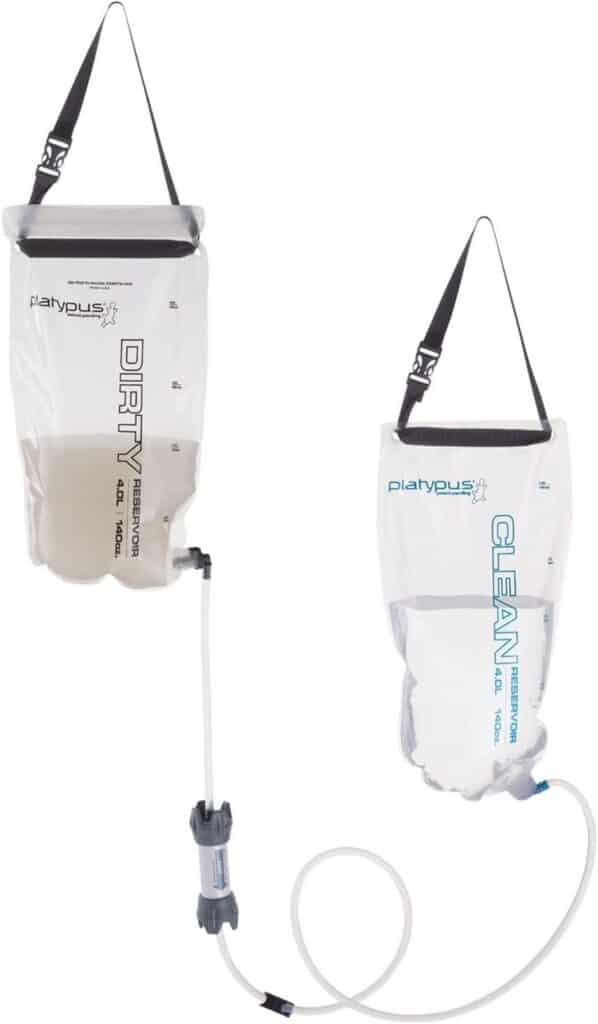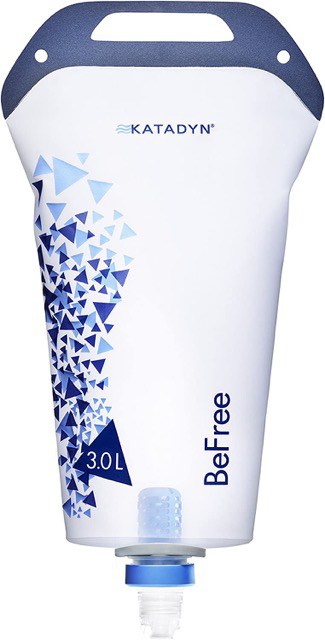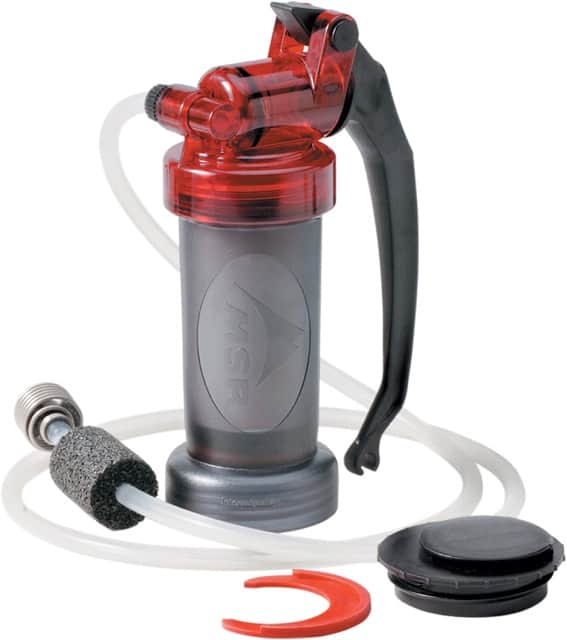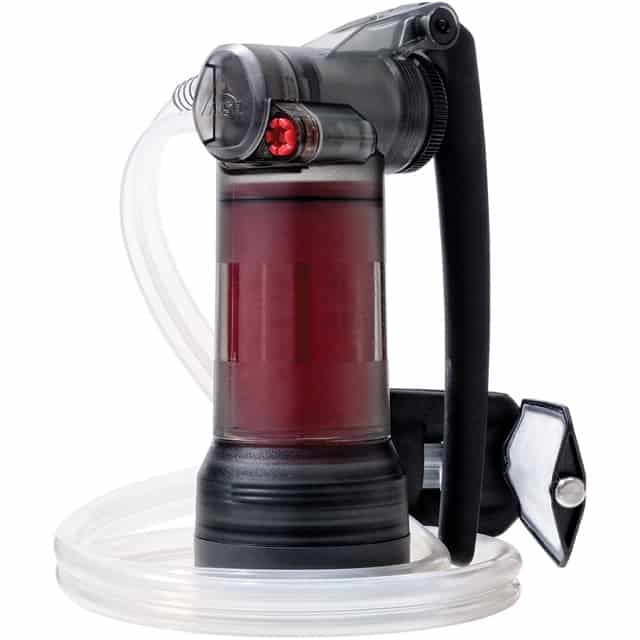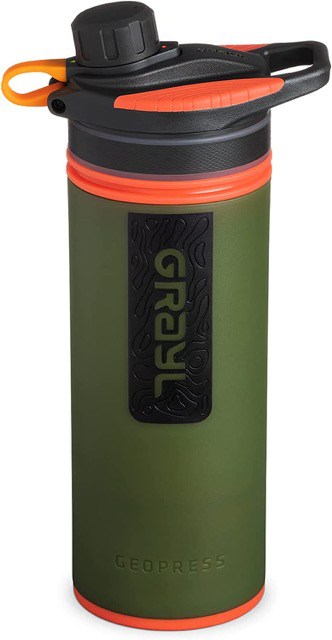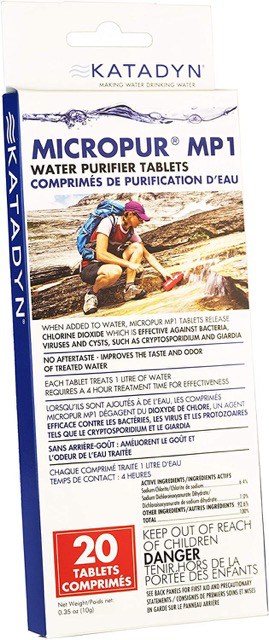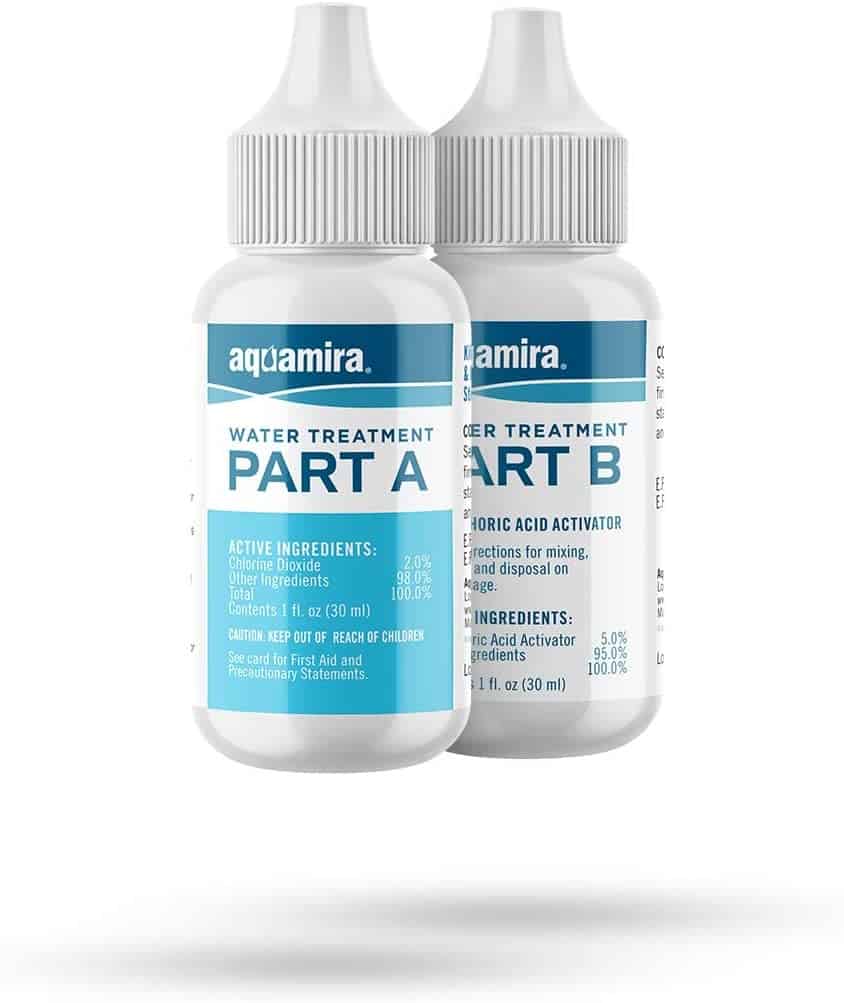Investing in the best backpacking water filter will allow you endless supplies of the most important resource on the trail. Find out which portable water purifiers we recommend for camping.
Regardless of how long you’ve been hiking, or how far you plan to hike, having a source of water on the trail is essential. And combining the best water bottle with a great water purifier, you can give yourself the peace of mind that you’ll be able to drink any water that you may come across on the trek.
Water purification for hiking has come a long way over the years. But now there are so many options for backpacking water filters out there that making the best choice can be a challenge.
We’ve been completing some of the most amazing incredible treks all around the world for years and can tell you from firsthand experience that investing in a great water filter should be near the top of your hiking essentials list.
In this post, we’ll give you everything you need to know about choosing the best water purifier for hiking and give you a few of our top recommendations.
Our Pick – Sawyer Squeeze
Great price
Easy to use with high-quality filtration
Packs and stores conveniently
Top Recommended Water Filters
PRODUCT | PRICE RANGE | FILTER TYPE | LIFETIME | FLOW RATE | WEIGHT | |
$30 - $50 | Bottle/Inline Filter | 100,000 gal | 1.7L/min | 3 oz | ||
$125 - $150 | UV Purifier | 8,000 L | 1L /90 sec | 4.9 oz | ||
$125 - $150 | Gravity Filter | 1,500 L | 1.75L/min | 11.5 oz | ||
$30 - $50 | Bottle Filter | 2,000 L | 3L/min | 3.9 oz | ||
$60 - $80 | Bottle Filter | 1,000 L | 2L/min | 2.3 oz | ||
$100 - $125 | Pump Filter | 2,000 L | 1L/min | 1 lb | ||
$350 - $400 | Pump Filter | 10,000 L | 2.5L/min | 1lb 2 oz | ||
$80 - $120 | Bottle Filter | 65 gal | 5L/min | 1 lb | ||
$10 - $20 | Chemical Purifier | 1L / tablet | 1L/30min | 1 oz | ||
$25 - $35 | Chemical Purifier | 30 gallons/1 oz | 1L / 20 min | 3 oz |
Table of Contents
The Best Backpacking Water Filter
Staying hydrated on the trail is a vital component of both your overall enjoyment and health. But the further you go away from the trailhead the harder it can be to source arguably nature’s most important offering.
As water sources dwindle or become increasingly sketchy, hikers, climbers, and all outdoor adventurers need to make use of one of the many effective water filters and purifiers.
Water, especially a source that isn’t flowing readily, can harbor a range of debris from as simple as dirt to little critters. Even worse, it can be a home to viruses, bacteria, and protozoa.
Your best bet to enjoy the water you drink and remain healthy on your trip is to filter your water effectively. How? Well, that’s what our guide will explore.
Editor’s Choice: Sawyer Squeeze
- Price Range: $30 – $50
- Filter Type: Bottle/Inline Filter
- Lifetime: 100,000 gal
- Flow Rate: 1.7L/min
- Weight: 3 oz
The Sawyer Squeeze is the cream of the crop for backpacking water filters. Filtering down to 0.1 microns, this water filter handles both bacteria and protozoa while providing users with an excellent flow rate.
Its versatility and ease of use make it a popular choice among both thru-hikers and weekend warriors. Fitting easily into your hiking pack, vest, or pocket, depending on your activity, you won’t have to worry about weight or packability.
Users can either attach the filter to their water bottle, or inclusive bladder and even make use of the complimentary straw filter. All of which help cover short to multi-day trips.
PROS
- Fast flow filter
- Lightweight and packable
- Offers great versatility
CONS
- Bladders aren’t durable
SteriPen Ultra
- Price Range: $125 – $150
- Filter Type: UV Purifier
- Lifetime: 8,000 liters
- Flow Rate: 1L/90 sec
- Weight: 4.9 oz
The SteriPen Ultra is efficient, lightweight and one of the best backpacking water filters on the market. This UV purifier has been around for years providing a stark difference from the classic gravity or chemical filter.
Rather than using force, the SteriPen Ultra eliminated viruses as well as bacteria and protozoa by utilizing ultraviolet light. It’s a rather simple exercise that requires placing the SteriPen into your bladder or bottle. Over the course of sixty seconds, the rays can purify a liter of water.
The SteriPen Ultra is light at only 2.9 ounces and offers a helpful USB-rechargeable battery.
PROS
- Lightweight and convenient
- Long lifetime use
CONS
- Doesn’t filter debris
- Needs recharge
Platypus GravityWorks
- Price Range: $125 – $150
- Filter Type: Gravity Filter
- Lifetime: 1,500 liters
- Flow Rate: 1.75L/min
- Weight: 11.5 oz
If you are outdoors with a large group or don’t mind being patient, the Platypus GravityWorks is a fantastic water filter. The gravity-fed system can take a minute to set up and be slow going, but it’s a time-tested method that can filter large amounts of water.
Simply hang one bag of dirty water above a second repository and let the water flow through the filter. While this is occurring you can sit back and relax, go over navigation or begin prepping for dinner.
The Platypus GravityWorks filters water down to 0.2 microns and removes debris creating 4 liters of clean and clear drinking or cooking water. Importantly, post-use, it packs down well.
PROS
- Great for bulk filtration
- Ease of filtration
CONS
- Requires large water source
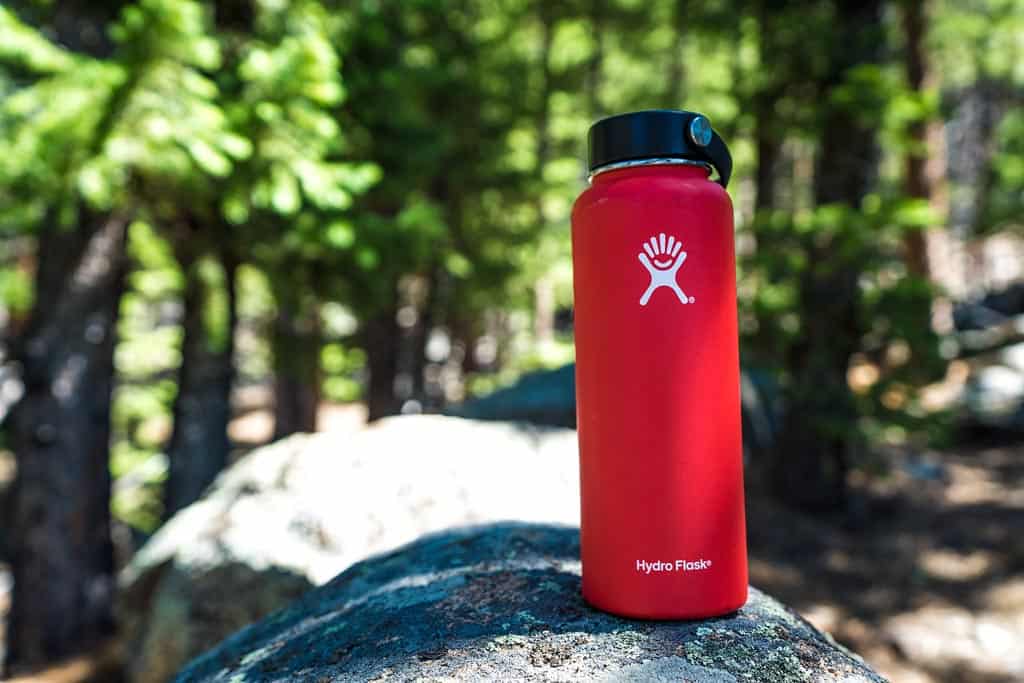
Lifestraw Peak
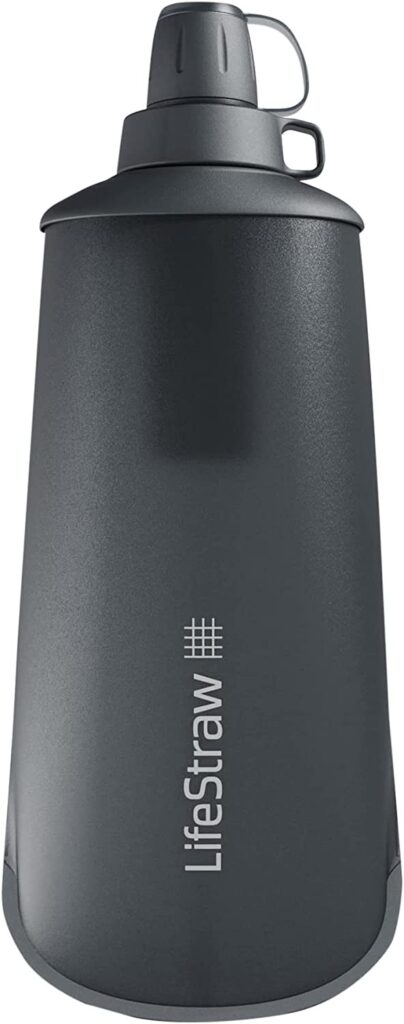
- Price Range: $30 – $50
- Filter Type: Bottle Filter
- Lifetime: 2,000 liters
- Flow Rate: 3L/min
- Weight: 3.9 oz
The Lifestraw Peak offers incredible convenience and versatility. The Peak comes with a 2,000-liter lifetime use and a mere 3.9 ounces in weight. Making use of its squeeze filter, the Lifestraw Peak sits on the end of the included flask and provides clean water after every compression.
Without having to carry anything bulky, you can simply fill up at each water source and have relatively instant and healthy H2O. If you have more time on your hands, the Lifestraw Peak also doubles as a gravity filter.
The flask does have long-term durability concerns, but you can simply place the filter on a standard water bottle.
PROS
- High flow rate
- Ready-to-go water
CONS
- Flask lacks durability
Katadyn BeFree Gravity Filter
- Price Range: $60 – $80
- Filter Type: Bottle Filter
- Lifetime: 1,000 liters
- Flow Rate: 2L/min
- Weight: 2.3 oz
With a great flow rate (for a large filter) of 2 liters a minute, the Katadyn BeFree Gravity Filter is a leader in its class. Not only is the BeFree exceptionally user-friendly, but it also works great for large groups who require more water than other filters can handle.
For a filter of its type, it’s lightweight at only 6.8 ounces with the capacity to provide three liters of filtered water at a time. In addition, the setup comes with an output that can fill up not just a large bladder, but multiple bottles or pots for boiling.
Lastly, the BeFree Gravity Filter requires no back flushing.
PROS
- Ease of filtration
- Great for large amounts of water
CONS
- Needs a place to hang
MSR Miniworks Ex
- Price Range: $100 – $125
- Filter Type: Pump Filter
- Lifetime: 2,000 liters
- Flow Rate: 1L/min
- Weight: 1 lb
The first pump filter in our guide, the MSR Miniworks Ex continues to rush against the trend of lighter filters. With a filter size of 0.2 microns, you can expect protection against contaminants. While the filter life of 2,000 liters places it above its pump counterparts.
The MSR Miniworks Ex utilizes quality materials within its carbon filter and ceramic design. This makes it easier to maintain and keep clean. The filter also is compatible with both dromedary bladders and broad-brimmed Nalgene.
Of course, the main drawbacks of pump filters are apparent here. It requires more work and, at 16 ounces, weighs more than most filters in our guide.
PROS
- Easy to maintain
- Compatible
- Long life
CONS
- Heavy
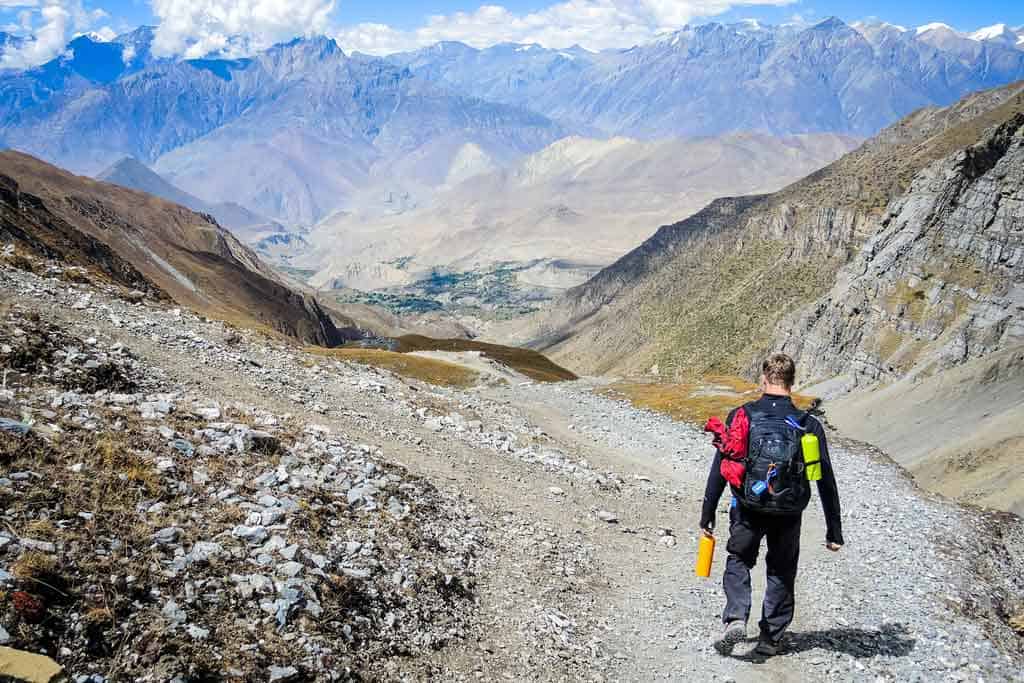
MSR Guardian Purifier System
- Price Range: $350 – $400
- Filter Type: Pump Filter
- Lifetime: 10,000 liters
- Flow Rate: 2.5L/min
- Weight: 1 lb 2 oz
The MSR Guardian Purifier System is a hollow fiber filter that while expensive is very efficient. Coming in at a hefty $400 range, the MSR Guardian lives up to its name and promises to protect you here and far away.
The military-grade quality of the filtration system means it requires only basic maintenance and offers self-cleaning. For the same reason, you won’t be surprised that this purifier has a fantastic lifetime use amount of 10,000 liters.
The main drawback is, of course, its weight. At over 17 ounces it’s best kept out of the backcountry.
PROS
- Fantastic flow rate
- High quality
CONS
- Very expensive
- Heavy
Grayl Geopress
- Price Range: $80 – $120
- Filter Type: Bottle Filter
- Lifetime: 65 gallons
- Flow Rate: 5L/min
- Weight: 1 lb
From one behemoth filter to another, the Gray Geopress water filter is 0.1 ounces short of a pound. BUt what you get for the weight is an innovative design that is part bottle, straw, and squeeze filter.
The Grayl Geopress works by making use of electro-absorption. All you have to do is fill the sleek 24-ounce bottle and press down on the interior plunger. This provides an exceptional filter time, while also purifying your water.
While effective against the most sketchy water, it isn’t the most practical option. It can only filter 0.7 liters at a time making it inefficient for backcountry travel.
PROS
- Fast filter time
- Easy to use
CONS
- Heavy
- Not always practical
Katadyn Micropur Purification Tablets
- Price Range: $10 – $20
- Filter Type: Chemical Purifier
- Lifetime: 1l/tab
- Flow Rate: 1L/30min
- Weight: 0.9 oz
For ease of use and filtration, chemical tablets are hard to top. The Katadyn Micropur Purification Tablets are the best of the lot, offering an effective, simple solution to dirty water.
For those on the trail for days or weeks at a time, the package’s overall weight of 0.9 ounces can’t be topped. Inside are enough tablets for thirty filtrations, with each tablet representing a liter.
It does, however, take more time than other options. Users will need to wait 15 minutes to filter water and eliminate bacteria and viruses with another fifteen required for Giardia.
PROS
- Easy to use
- Ultralight
CONS
- Takes time to purify
- Doesn’t eliminate debris
Aquamira Purification Drops
- Price Range: $25 – $35
- Filter Type: Chemical Purifier
- Lifetime: 30 gallons/1 oz.
- Flow Rate: 1L/20 min
- Weight: 3 oz
The main rival to Micropur tablets, Aquamira Purification Drops uses chlorine dioxide drops to purify water. The drops eliminate viruses, bacteria, and protozoa and at a total weight of 3 ounces, it’s a lightweight choice for multi-day expeditions.
The process compared to tablets, however, can prove to be tedious. Rather than wait an allocated amount of time, you must mix seven drops from Part A and Part B bottles. After waiting five minutes, you can then add it to one liter of water.
PROS
- Won’t malfunction
- Lightweight and simple
CONS
- Process takes time
Choosing the Best Backpacking Water Filter
Filters vs. Purifiers
Before we begin, it’s key we clear up the key differences between a water filter and a purifier. A water filter helps to protect users against parasites like giardia and bacteria, such as E. coli. Aside from helping rid your water of harmful infectants, the filter will also clear debris and dirt.
A purification method is just one step further, combining the elimination process used in filters with chemical treatments or UV light. This is a more thorough method that is best used where clean drinking water isn’t readily available, such as on international travel.
For unsafe water that is also visibly dirty, you may wish to use a combination of both filtering and chemical treatments before boiling the water.
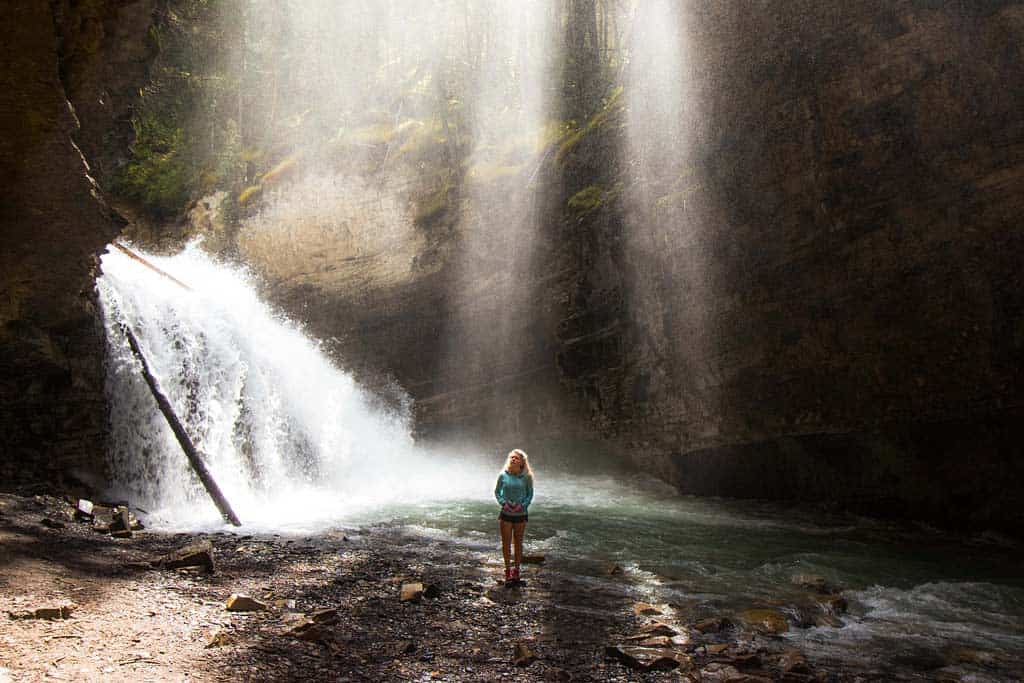
Filter Type
- Squeeze
Squeeze filters, also known. as bottle filters are common sights on long-distance trails. Their lack of weight and decent versatility makes them a handy addition to any overnight trip. These qualities also make this option a top choice for cyclists and ridge runners.
The squeeze filter works by attaching itself to a soft-shelled bottle or bladder. You can then squeeze the water through the filter, into your mouth, or a separate storage item. But you don’t always have to squeeze. These filters can also work as gravity filters.
- Gravity
A gravity-fed water filter is very much what its name suggests. Simply hang the uncleaned water at a good height, say around a tree, and let gravity do its work. Slowly the water passes through the filtration and drips into a clean reservoir.
This is a fairly straightforward setup, although it can take some time to get working. It’s best used in larger groups, such as on family trips or outdoor education where large quantities of water make the most sense.
Such a large bag, however, may be overkill for single hikers or smaller groups, though there are some small options. You’ll also need to make sure you have the option to hang the bag.
- Straw
When it comes to convenience, it’s hard to top the effect of a straw filter. These are a popular choice among high-octane adventurers who need to save weight and not carry large amounts of water.
All users have to do is find their chosen source of water and sip it like they would an everyday straw. This filter, however, will block harmful bacteria and debris before it reaches your mouth.
While convenient, straw filters have limited uses. They are great on the go but lack the ability to keep clean water on your person, in readiness for camp or cooking. This puts a straw filter beyond many multi-day trips.
- Pump
Pump filters were once the kings of this domain. Using basic mechanics, these filters were able to access water from even the smallest of puddles and deposit the clean H2O in a bottle or bladder.
However, with improved technology, the effort required for pumping the water through a filter or purifier is no longer a necessity. In addition, a pump filter requires more maintenance to cleanse the cartridges and the overall setup is much heavier than other options.
- Chemical Water Purification
Chemical treatment is the OG of water purification. It’s simple, lightweight, and effective. Chemical water purifiers use either chlorine or iodine in order to eliminate viruses, protozoa, and bacteria.
They are a popular choice among all kinds of hikers, climbers, and cyclists for single and multi-day adventures. You’ll save on weight and size, all without the effort of squeezing or setting up a gravity drip.
The drawbacks, however, are the lack of filtration. Debris won’t be eliminated, while the addition of chemicals can change the taste of the water…
- UV Light Water Purification
A modern solution to an age-old problem, UV light water purifiers are effective and lightweight. Similar to the chemical treatment method, UV light purifiers don’t require much effort and remove viruses alongside bacteria and protozoa.
As efficient as this method is, it doesn’t remove dirt and debris, so it’s most effective for clearer water. Although you won’t have the taste of chemicals as you drink, UV filters need batteries to function which can be risky in the backcountry.
Weight and Packability
Once you step onto the trail, every ounce on your back counts. The weight of filters and purifiers varies from chemical treatments which are lightweight and small to gravity filters which weigh up to a pound and are bulky.
If you want to save weight but prefer something other than chemical tablets, a squeeze filter may be the best choice. These are often a few ounces and while larger than tablet boxes, won’t take up much room. Large systems such as gravity and pump filters require more space.
In the end, your filter is only one part of the puzzle. The water it filters will also add space whether that’s a 1-liter bottle or bladder.
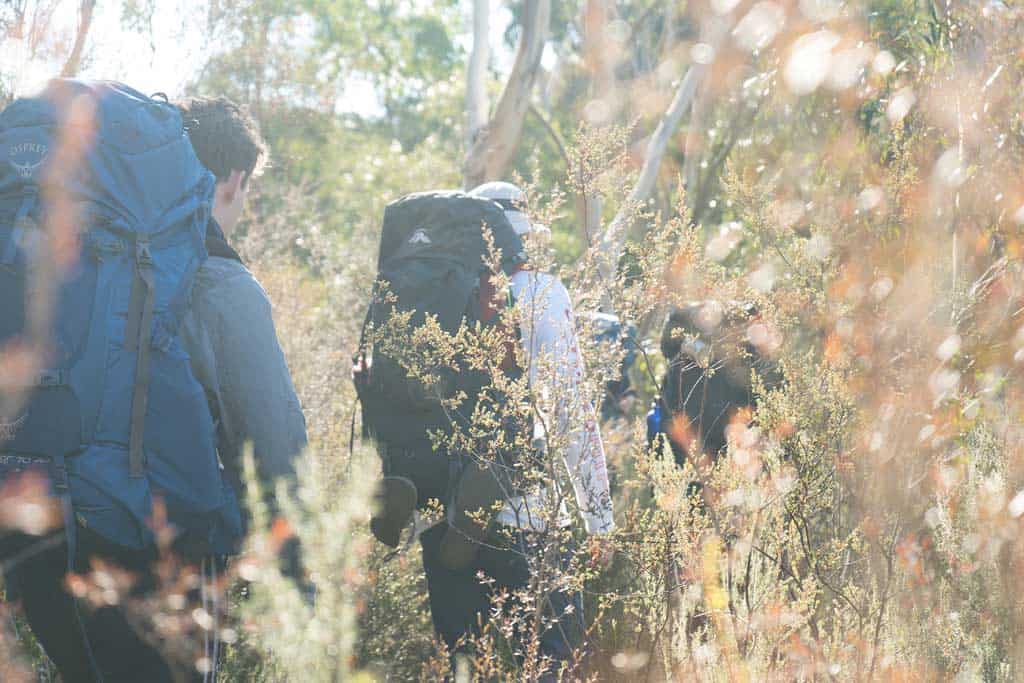
Ease of Setup & Breakdown
Depending on your situation, you may have lots or little time to deal with water filtration. For some, a thirty-minute break to filter and enjoy the view won’t sound like a bad deal. Yet for others, time is of the essence.
In terms of ease of setup and breakdown, chemical treatments, squeeze, and straw filters are the simplest. Depending on the type of product, they can also be quick to provide you with clean drinking water.
Gravity and pump filters take some time to set up. For a gravity filter, you’ll need to stake out an appropriate spot while for pump filters, the number of components can take a minute to assemble.
Ease of Filtration
This looks at how hard one has to work to get water through the filter and ready for use. UV purifiers and chemical tablets require no physical effort. Once set up, gravity filters are easy, as the power of the earth’s core does all the work for you.
Squeeze and pump filters require the most effort. The former can sometimes have you squeezing for little return. While the latter requires constant hand movement. However, with pump filters, you get a greater return for the effort.
Flow Rate & Volume of Water Capacity
As the above table explains, the difference in flow rate varies drastically between all our favorite options. This isn’t necessarily a bad thing as all choices have their pros and cons, along with providing solutions to different problems.
The variation in time has everything to do with the type of filter and purification. If time efficiency is high on your priority list, then analyzing the flow rate will be an important part of your decision.
Flow rate is how quickly water makes its way through the filter or purifier. But it’s worth noting that before you can use some filters, they’ll need to be backflushed, which adds some time.
While some options, like gravity filters, take longer, they have the capacity to filter more water than that straw and squeeze filters. This makes it a better choice for trips where water is sparse.
Cleaning and Maintenance
Maintaining the quality of your filtration systems is a necessity. Other gear you can wear down to an inch of its life. But with your filter, it’s vital you keep in clean and maintained so it can both function correctly and serve its purpose of keeping you healthy on the trail.
Cleaning and maintenance vary by filter and purifier. Some, like gravity filters, require a simple backflush prior to each use. Others, like a squeeze filter, often have separate syringes.
If cleaning and maintenance sound like too much hassle, a chemical option is a simple choice.
The Wrap Up
With each water filter offering a different use, there is bound to be one that suits your chosen style of adventuring. Lightweight and efficient options make filtering water much easier in the backcountry. While sturdy, durable, and heavy filters provide bulk water in camps for families and hiking groups.
It’s important to match your style of activity to your chosen filter to make the most of its pros and to help mitigate its weaknesses. However, if you pursue a range of different adventures, from trail running to multi-day alpine treks, the Sawyer Squeeze proves to be the most flexible.
EDITOR’S CHOICE:
Sawyer Squeeze
The Sawyer Squeeze is lightweight, and can also act as a gravity or straw filter while providing quick and easy access to clean water.
The Sawyer Squeeze has been an industry leader for quite some time.
You’ll see this simple invention across many trails from the front country to the high alpine.
This is because it offers users a high flow rate, and great effectiveness all the while being easy to use and lightweight.
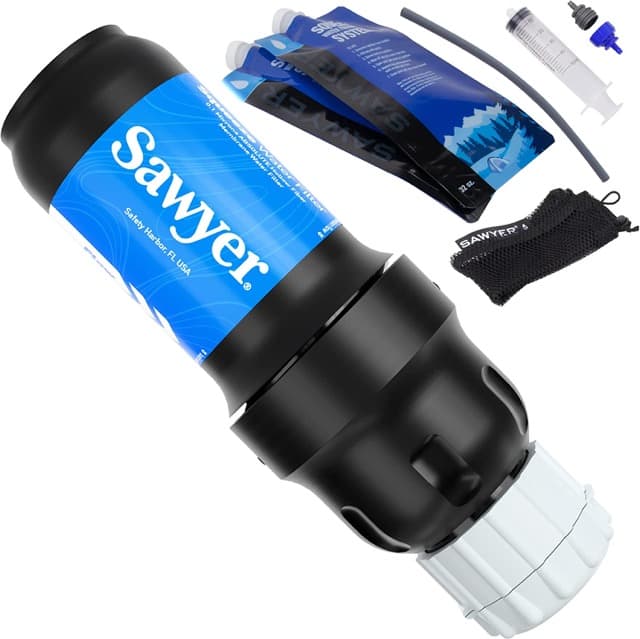
With a filtration system that eliminates bacteria and protozoa down to 0.1 microns, the Sawyer Squeeze is more effective than other options which offer a rate of 0.2 microns.
It’s easy to use thanks to its compatibility. Make use of the inclusive bladders or hook it up to your 1-liter bottle.
From there, compress and watch the clean water flow out. In 60 seconds you can have over 1.5 liters of water.
DISCLAIMER: Some of the links in this article are affiliate links, which means if you book accommodation, tours or buy a product, we will receive a small commission at no extra cost to you. These commissions help us keep creating more free travel content to help people plan their holidays and adventures. We only recommend the best accommodations, tours and products that ourselves or our fantastic editorial team have personally experienced, and regularly review these. Thanks for your support, kind friend!


